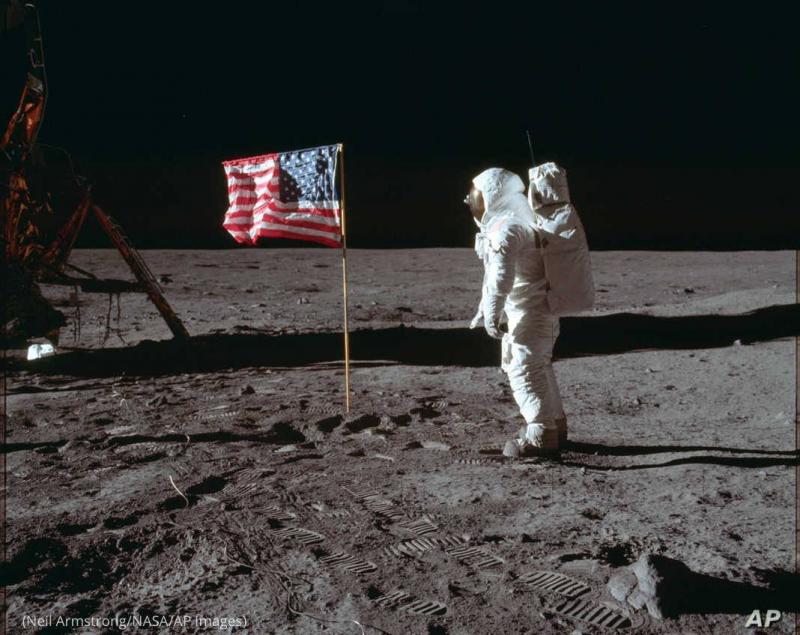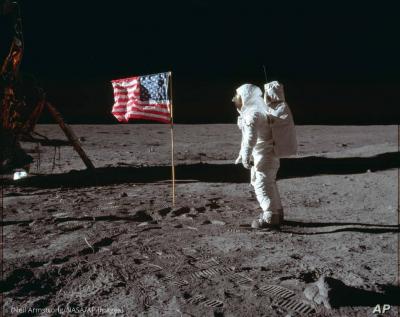The world celebrates on July 20 the arrival of humans on the moon in 1969, a time when competition between private companies to send their crewed spacecraft into space for exploration or tourism has intensified. Today, Tuesday, the richest man on the planet and founder of Amazon, Jeff Bezos, plans to be aboard the first crewed flight of a spacecraft developed by his company "Blue Origin" to the edge of space.
On July 20, 1969, American astronauts Neil Armstrong and Buzz Aldrin became the first humans to step onto the moon, while their colleague astronaut Michael Collins oversaw the command module. On the left: Neil Armstrong, team leader, Michael Collins, command module pilot; Edwin E. Aldrin, lunar module pilot, on March 30, 1969. Neil Armstrong, at the front, waved his hand, heading towards the truck that would transport the crew to the rocket for their launch to the moon at Kennedy Space Center on Merritt Island, Florida, on July 16, 1969. All Apollo 11 crew members participated in at least one spaceflight.
The "Saturn V" rocket, measuring 363 feet tall and carrying the Apollo 11 crew, was launched on July 16, 1969, from Kennedy Space Center in Florida, with the Saturn V rocket being launched from Kennedy Space Center in Florida.
American astronaut Michael Collins, who accompanied the Apollo 11 mission, passed away last April at the age of 90. NASA stated at the time, "The nation has lost a true pioneer today, a lifelong advocate for space exploration."
Photos of the footprints were actually part of a planned experiment by Aldrin to study the nature of moon dust and pressure effects on the surface. The statement noted that Collins was the pilot of Apollo 11's command module, which went to explore the moon in 1969. He was described by some as "the loneliest man in history." The reason for this title was that he was alone in the "Columbia" spacecraft for over 21 hours, waiting for his companions who went to explore the moon's surface.
For 50 years after this event, Collins was often asked a single recurring question: "How did it feel to sit alone in space?" In a press interview he gave in the 1960s, Collins stated he was busy completing all the necessary tasks to the letter, saying, "There was no room for error that day."
Collins was not worried about the trip of his buddies who separated from the main spacecraft and went to the lunar module. "I was sure everything would be fine; Neil (Armstrong) is a very skilled pilot, and although we knew the moon's surface was full of obstacles, it also had areas that were easy to land on."
However, what worried Collins was the return trip of his companions to the main spacecraft he was waiting in; Armstrong and Aldrin could have gotten stuck in lunar orbit if any error had occurred with the lunar module's engine. Collins was planning maneuvers in an effort to reach them if their spacecraft malfunctioned and stated he prepared 18 contingency plans.
Nevertheless, Collins could have returned to Earth alone. "I would not have committed suicide... I would have returned alone, and they knew that... but it wouldn't have been a happy trip." The mission ended successfully, and Armstrong and Aldrin safely returned to the spacecraft, which later landed in the Pacific Ocean.
The three astronauts and a member of the Navy SEALs, all wearing biosafety suits, waited for helicopters to transport them to the USS Hornet after the lunar module landed on July 24, 1969. They remained in quarantine for three weeks.
When Armstrong became the first human to step onto the moon, he said, "That's one small step for a man but a giant leap for mankind." Today, alongside NASA, private companies are competing to conduct space flights.
### The Return to the Moon
Technicians and engineers at the Kennedy Space Center in Florida have assembled the main part of the rocket body, known as the "SLS," short for "Space Launch System," and placed it between two support rockets in preparation for the return to the moon. This rocket is scheduled to launch in November this year, sending the "Orion" spacecraft as part of the "Artemis-1" mission on an uncrewed test flight around the moon lasting about three weeks. There will be no astronauts aboard this flight, as the current purpose is to test it for future lunar missions in cooperation with the private sector.
The "Artemis-3" mission, contracted to SpaceX, is planned to be the first mission to send humans back to the moon since Apollo 17 in 1972, with a man and a woman expected to land on the lunar surface in 2023. SpaceX wrapped up a recent test of its "Starship" vehicle chosen by NASA for the upcoming mission.
### NASA's Ambitious Plans
Last month, NASA announced its plans to launch two exploration missions to Venus between 2028 and 2030. If these missions are successful, the United States will return its spacecraft to Venus for the first time in 30 years. The selected missions come as part of a set of tasks that participated in the "Discover 2019" competition launched by the agency.
NASA chose the "DAVINCI+" and "VERITAS" missions to reach Venus, stating that it will allocate about $500 million for the development of each. NASA Administrator Bill Nelson expressed hope that these missions would enhance our understanding of how Earth evolved and why it is currently habitable while other planets in our solar system are not. He added, "Planetary science is crucial in answering key questions we have as humans, such as: Are we alone?"
According to the agency, the upcoming missions aim to understand how Venus became "hellish," despite having multiple characteristics similar to Earth. NASA suggests that Venus might have been the first habitable world in the solar system with an ocean and a climate resembling that of Earth.
The "DAVINCI+" mission will explore the composition of Venus's atmosphere to understand how it formed and evolved. It will also investigate whether there was once an ocean on Venus's surface and study the planet's geological composition. Meanwhile, the "VERITAS" mission will map Venus's surface, helping to determine the planet's geological history and understand the reasons behind its different evolution from Earth. It will also explore the composition of Venusian rocks and determine whether there were previously active volcanoes that released water vapor into the atmosphere.
### Private Space Flights
Today, Jeff Bezos, the richest man on this planet and founder of Amazon, is set to be aboard the first crewed flight of a spacecraft developed by his company "Blue Origin."
"SpaceX" has made headlines and broken records with its rocket technology, which is entirely different from what Bezos's company will launch for the first time today. "SpaceX" builds orbital rockets, which require sufficient thrust to reach at least 17,000 miles per hour, known as orbital velocity, essentially providing the spacecraft enough energy to maintain orbit around the Earth rather than being immediately pulled down by gravity.
With this technology, "SpaceX" can deploy satellites into orbit or transport astronauts to and from the International Space Station. Just nine days ago, billionaire and rocket company founder Richard Branson (70) completed his first private journey to space. However, the technology developed by Bezos to take him beyond Earth differs significantly from Branson's flight, according to CNN.
The "New Shepard" capsule made by "Blue Origin" is a small suborbital rocket that launches vertically from the launch pad, providing a shorter but faster experience than the spaceplane launched from the air created by Branson's "Virgin Galactic."
Businessmen Richard Branson, Musk, and Bezos are often compared due to their similarities, as all three have used the fortunes amassed from other businesses to pursue space-focused projects.




